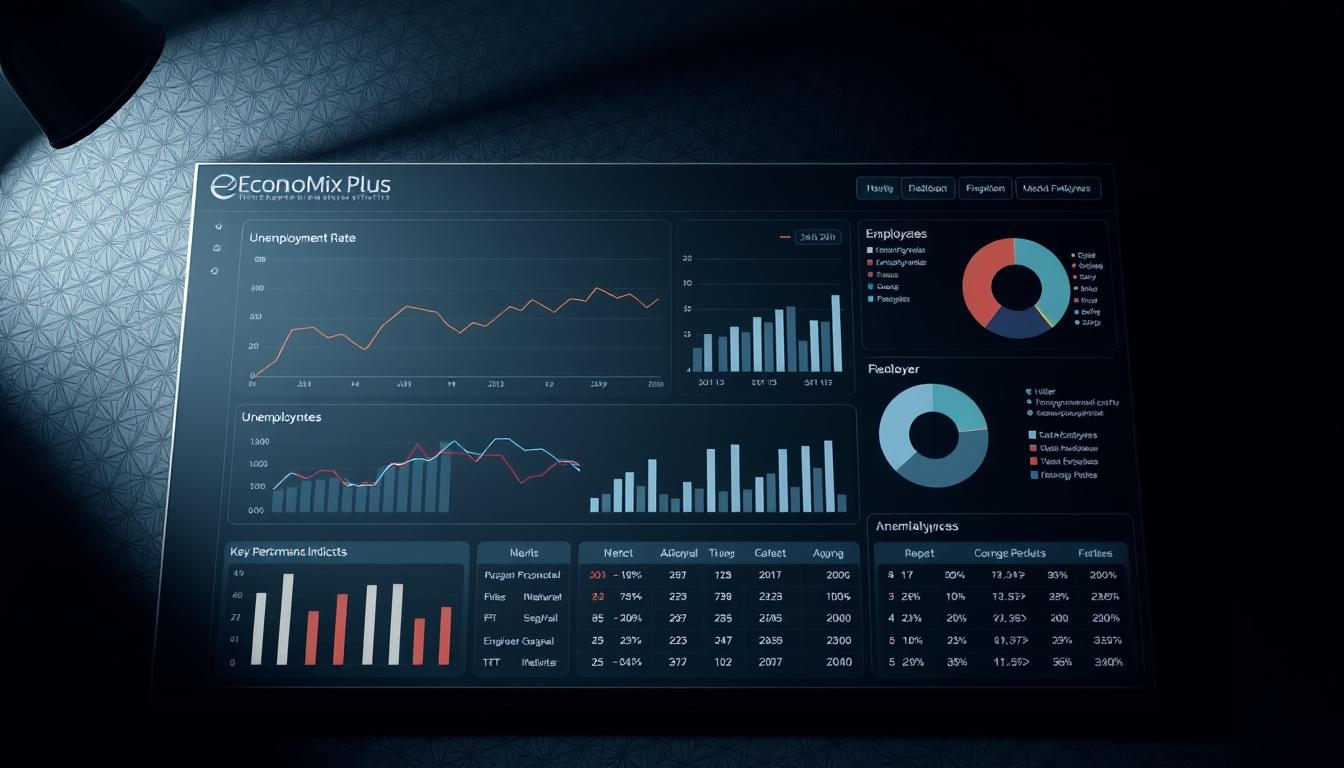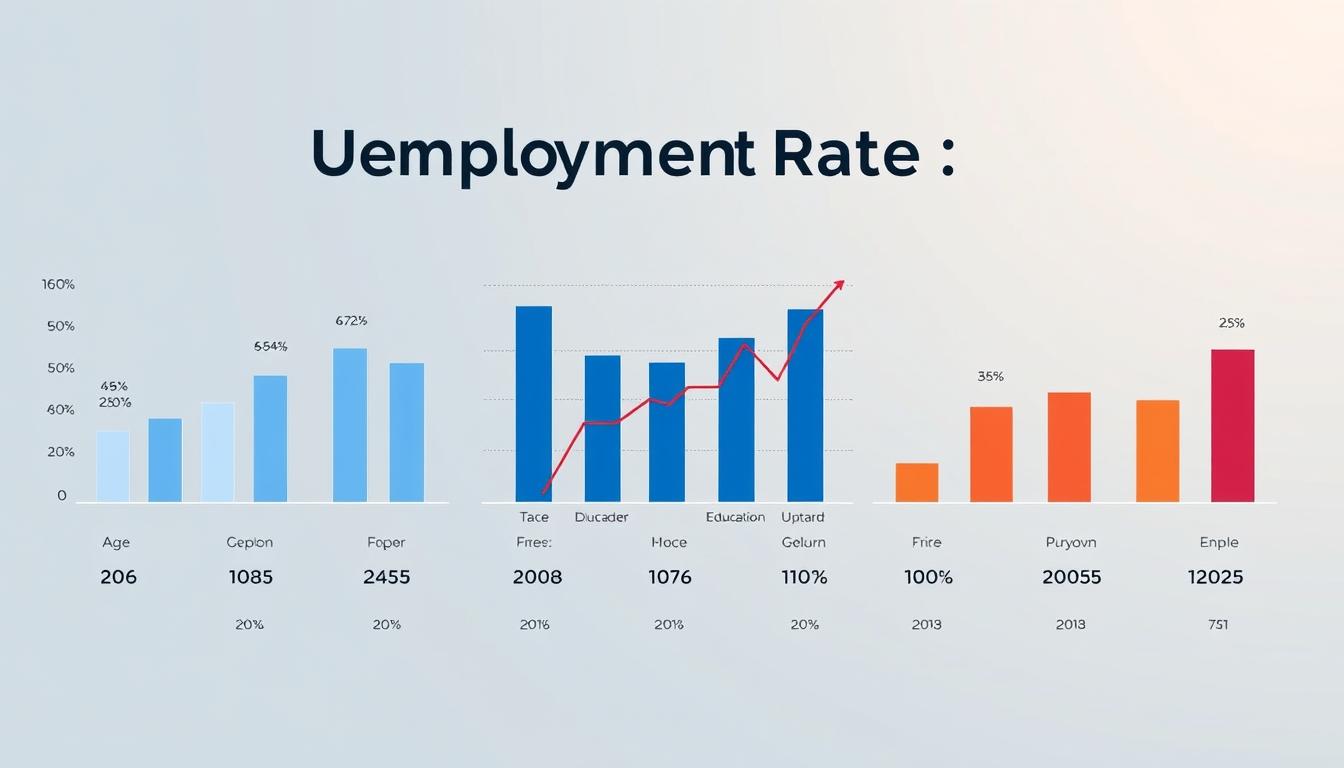You’re likely aware that the unemployment rate is a crucial indicator of a nation’s economic health. But have you ever stopped to consider what it really signifies? Is it a reflection of broader economic weakness, or is it a result of specific policy failures?
The COVID-19 pandemic has brought the issue of unemployment to the forefront, exposing fundamental flaws in labor markets across the United States. As we navigate the complexities of unemployment, it’s essential to understand its underlying causes and how it affects different demographic groups and regions.
As we explore the intricacies of the job market and employment landscape, we’ll examine the historical patterns of unemployment rate and discuss potential policy approaches to address these challenges.
Key Takeaways
- The unemployment rate is influenced by both macroeconomic conditions and specific policy frameworks.
- Understanding unemployment requires looking beyond simple statistics.
- Demographic factors significantly influence unemployment rates.
- The COVID-19 pandemic highlighted weaknesses in unemployment systems.
- Effective policy approaches are crucial to addressing unemployment challenges.
Understanding Unemployment in the Modern Economy
As you navigate the complexities of the modern economy, understanding unemployment becomes crucial. The unemployment rate is a key indicator of the economy’s health, reflecting the number of people actively seeking work but unable to find it. This figure not only highlights the immediate challenges faced by individuals but also serves as a barometer for broader economic trends, influencing consumer confidence and spending. High unemployment can lead to reduced economic activity, as those without jobs have less disposable income to contribute to the market, further exacerbating economic downturns.
Defining Unemployment and Its Measurement
The Bureau of Labor Statistics (BLS) officially measures unemployment. To be counted as “unemployed,” an individual must be actively seeking employment but currently out of work. The unemployment rate is calculated by dividing the number of unemployed individuals by the total labor force, expressed as a percentage.
The standard unemployment rate (U-3) has its limitations. It doesn’t account for discouraged workers who’ve given up looking for jobs or those working part-time who desire full-time employment. Alternative measures like U-6 provide a broader picture, including these groups.
| Unemployment Measure | Description | Inclusion Criteria |
|---|---|---|
| U-3 | Standard Unemployment Rate | Actively seeking work, available to work |
| U-6 | Broader Unemployment Measure | Includes U-3 plus discouraged workers, part-time workers seeking full-time employment |
The Evolving Nature of Work and Employment
The nature of work has dramatically evolved since the inception of unemployment insurance systems. The rise of gig work, remote work, and part-time employment has transformed what “employment” means. Traditional employment relationships have given way to more complex arrangements, often leaving workers in precarious positions not well-captured by traditional unemployment statistics.
As the economy continues to evolve, it’s essential to adapt our understanding of unemployment and its measurement to accurately reflect the modern labor market. This includes considering the impact of technology on industries and the creation of new types of work.
Historical Patterns of U.S. Unemployment
The historical pattern of U.S. unemployment since 1955 reveals fluctuations that are closely tied to the state of the economy. As we examine the data presented in Figure 21.3, several key patterns emerge that characterize the American labor market. Notably, these fluctuations often correspond with significant economic events, such as recessions and recoveries, which have shaped the workforce landscape. For instance, the economic downturns have led to sharp increases in unemployment rates, while periods of growth have typically resulted in lower unemployment figures. This cyclical nature highlights the responsiveness of the labor market to broader economic trends and the challenges faced by policymakers in addressing unemployment during various phases of the economic cycle.
Unemployment Trends Since the 1950s
Unemployment rates have fluctuated significantly over the decades. During the deep recessions of the early 1980s, 2007-2009, and 2021, unemployment rates peaked at around 10%. In contrast, during the late 1990s and mid-2000s, unemployment rates were relatively low, dropping below 5% from 1997 to 2000 and remaining near 5% from 2006 to 2007. The unemployment rate also stayed at 5% or less from September 2015 through March 2020, a feat not achieved in three decades.
The relationship between economic growth and unemployment is evident, with unemployment rates typically decreasing during periods of economic expansion. However, the unemployment rate never reaches zero; it rarely dips below 3% and only for short periods.
Recession Impacts on Unemployment Rates
Recessions have a profound impact on unemployment rates, causing them to spike significantly. The early 1980s, 2007-2009, and 2020-2021 recessions are notable examples where unemployment rates surged. The timing of rises and falls in unemployment matches fairly well with the overall economy’s upswings and downswings, although unemployment tends to lag behind changes in economic activity, especially during recoveries.
| Recession Period | Peak Unemployment Rate | Duration of High Unemployment |
|---|---|---|
| Early 1980s | 10% | Several months |
| 2007-2009 | 10% | Over a year |
| 2020-2021 | Around 6% | Several months |
Understanding these historical patterns is crucial for analyzing the labor market’s response to economic changes and for informing policy decisions aimed at mitigating the impacts of future recessions.
Does Unemployment Reflect Economic Weakness or Policy Failures?
As unemployment continues to be a pressing issue, the question remains: does it reflect underlying economic problems or shortcomings in policy design? The answer to this question is complex and multifaceted.
Economic Weakness Perspective
The economic weakness perspective views unemployment as a symptom of broader economic issues. Factors such as insufficient aggregate demand, technological disruption, and global competition contribute to displacing workers. Structural economic changes, including automation, globalization, and the shift from manufacturing to services, have created persistent unemployment challenges.
- Technological advancements replacing certain job roles
- Globalization leading to outsourcing and job displacement
- Shift in industry structures affecting labor demand
These changes indicate that unemployment can be a result of deeper economic issues rather than just policy failures. The unemployment rate is influenced by the overall state of the economy and labor market conditions.
Policy Failure Perspective
On the other hand, the policy failure perspective argues that unemployment often results from governmental shortcomings. Areas such as education, workforce development, labor market regulation, and unemployment insurance design are critical. Policy choices regarding minimum wage, worker protections, and unemployment benefits directly impact unemployment rates.
For instance, inadequate policies can lead to:
- Insufficient training programs for workers
- Ineffective labor laws that fail to protect workers
- Government policies that inadvertently discourage hiring
Both perspectives highlight that unemployment is influenced by a combination of economic conditions and policy decisions. Understanding this complex interplay is crucial for addressing unemployment effectively.

Limitations of Unemployment Statistics
You may be surprised to learn that the unemployment rate doesn’t tell the whole story about labor market conditions. While it’s a widely used indicator of economic health, it has several significant limitations that can lead to an incomplete understanding of the labor market.
Discouraged Workers and Underemployment
One of the primary limitations is that the unemployment rate doesn’t account for discouraged workers. These are individuals who have stopped looking for jobs due to a lack of available positions or because they believe they’re not qualified for any openings. As a result, they’re not counted as unemployed, potentially underestimating the true extent of joblessness. Additionally, the unemployment rate doesn’t capture underemployment, which refers to people working part-time or in low-skilled jobs when they’d prefer full-time or higher-skilled positions.
For instance, consider a college graduate working as a barista because they can’t find a job in their field. They’re counted as employed, but their employment situation doesn’t align with their skills or qualifications. This underutilization of human resources can have long-term effects on the economy.
Informal Employment and Statistical Gaps
Another issue with the unemployment rate is that it may not accurately capture people working in informal sectors. Informal employment includes jobs that aren’t formally regulated or recognized by the government, such as street vendors or unregistered workers in family businesses. These workers might not be officially counted as employed, which can lead to an overestimation of joblessness.
| Category | Included in Unemployment Rate | Impact on Labor Statistics |
|---|---|---|
| Discouraged Workers | No | Underestimates joblessness |
| Underemployed Workers | Yes, but counted as employed | Masks underutilization of skills |
| Informal Sector Workers | Not always | Can lead to overestimation or underestimation |
As you can see, the limitations of unemployment statistics can significantly impact our understanding of labor market health. By recognizing these limitations, we can work towards a more comprehensive view of employment conditions.

Demographic Disparities in Unemployment
Unemployment rates vary significantly across different demographic groups, revealing underlying economic and social disparities. Understanding these disparities is crucial for developing targeted policies to address unemployment.
Unemployment by Gender and Age
Historically, the unemployment rate for women was higher than that for men, reflecting the traditional view of women as “secondary” earners. However, by around 1980, women’s unemployment rates became roughly equal to those of men. During the 2020 pandemic-induced recession, women’s unemployment rates temporarily exceeded those of men before narrowing again. Age is another significant factor, with younger workers experiencing higher unemployment rates due to job mobility and the process of matching workers with appropriate jobs. In contrast, middle-aged workers tend to have lower unemployment rates, likely due to their greater sense of responsibility and job stability. Elderly workers have very low unemployment rates, as many exit the labor force through retirement.

Racial and Educational Disparities
The unemployment rate for African-Americans is substantially higher than for other racial or ethnic groups, reflecting historical and ongoing discrimination in the labor market. Although the gaps between unemployment rates for White, Black, and Hispanic individuals have diminished since the 1990s, significant disparities remain. Educational attainment is also strongly correlated with unemployment risk. Individuals with higher levels of education, such as college graduates, have significantly lower unemployment rates (2.3% in November 2021) compared to those with less education, such as high school graduates without additional degrees (5.2%) or those without a high school diploma (5.7%). This disparity arises because higher education typically offers better labor market connections and higher demand.
- Unemployment affects different demographic groups unequally, with certain groups facing higher rates of joblessness.
- Racial and ethnic minorities, as well as those with lower educational attainment, are disproportionately affected by unemployment.
- Understanding these demographic disparities is essential for crafting effective policies to reduce unemployment.
The Unemployment Insurance System: Structural Issues
The U.S. unemployment insurance (UI) system is facing a critical juncture, necessitating a comprehensive overhaul to address its outdated design and eligibility criteria. The current UI system was established during the New Deal era, and its framework still reflects the economic conditions and labor market characteristics of that time.
Outdated Design and Eligibility Criteria
The UI system’s eligibility standards and benefit structures are based on outdated assumptions about typical workers and employment patterns. For instance, the system assumes that workers are primarily male factory workers who experience temporary layoffs and then return to their previous jobs. However, the modern labor market is more diverse, with a significant presence of women, part-time workers, and those engaged in non-traditional employment arrangements. As a result, many workers, particularly women, people of color, and individuals with disabilities, are often excluded from receiving UI benefits or receive inadequate support.
- The UI system’s design fails to account for the growing prevalence of part-time and gig work.
- Eligibility criteria, such as minimum earnings thresholds, often disqualify workers with non-traditional work histories.
- The system’s focus on temporary layoffs does not address the needs of workers facing permanent job losses or career transitions.
State-Level Variations and the “Race to the Bottom”
The administration of UI at the state level has led to significant variations in benefit levels and eligibility criteria across different states. This decentralization has created a “race to the bottom,” where states compete to offer lower benefits and stricter eligibility to keep business taxes low. Consequently, workers in different states have unequal access to UI benefits, with those in states with more restrictive policies often receiving less support.
To address these issues, it is essential to reform the UI system to better align with the contemporary economy and labor market. This includes updating eligibility criteria to cover a broader range of workers and employment arrangements, as well as ensuring that benefit levels are adequate to support workers during periods of unemployment.
International Perspectives on Unemployment
The U.S. unemployment rate is often viewed as competitive when compared internationally, but this comparison requires careful consideration. Different countries have varying definitions of unemployment, survey tools, and labor market structures, making direct comparisons challenging.
Comparing U.S. Unemployment with Other High-Income Countries
When comparing the U.S. unemployment rate to other high-income countries, it’s essential to consider these differences. For instance, Japan’s unemployment rates appear low, but this masks underlying issues in its labor market, such as workers exiting the labor force or being underemployed. The U.S. rate typically looks a little better than average compared to other developed economies.
Different Approaches to Unemployment Support
Countries employ various strategies to support unemployed workers. For example, Germany uses work-sharing programs, Denmark implements the flexicurity model, and Sweden employs active labor market policies. These approaches not only provide financial support but also help workers transition back into employment. Understanding these different strategies can offer insights into potential improvements for U.S. unemployment policies.
By examining international perspectives on unemployment, you can gain a deeper understanding of how different economies address this complex issue. The experience of unemployment and the measurement of unemployment rates vary significantly across countries, influenced by social safety nets and cultural attitudes toward work and employment.
Case Study: Unemployment During the COVID-19 Pandemic
The economic shock of the COVID-19 pandemic laid bare the shortcomings of the U.S. unemployment insurance system. As the pandemic swept through the economy, millions of workers found themselves unemployed, often through no fault of their own.
System Failures Exposed by the Pandemic
The sudden, massive influx of claims in March 2020 overwhelmed many state UI programs. Computer systems crashed, and telephone helplines were perpetually busy. By the fall, reports were widespread of people waiting weeks—or months—for their benefits. According to a study published on PMC, the pandemic highlighted the need for modernizing state UI systems to handle such large volumes.
The delays and inefficiencies exposed underlying issues with the nation’s UI system, including outdated technology and inadequate administrative infrastructure. These systemic problems were further complicated by the unprecedented scale of job losses during the pandemic.
| Program | Purpose | Impact |
|---|---|---|
| Pandemic Unemployment Compensation (PUC) | Supplemental $600 weekly benefit | Hugely important for millions of Americans |
| Pandemic Emergency Unemployment Compensation (PEUC) | Extended duration of benefits | Provided sustained support to workers |
| Pandemic Unemployment Assistance (PUA) | Benefits for self-employed and non-traditional workers | Brought help to a broader swath of the workforce |
Temporary Solutions and Their Effectiveness
In response to the crisis, the federal government implemented several temporary UI programs, including PUC, PEUC, and PUA. These programs were critical in supporting workers and stabilizing the economy. For example, PUA provided benefits to about 7.5 million workers who otherwise would have been without them as of March 2021.
While these temporary measures were effective in the short term, they also highlighted the need for structural reforms to create a more resilient UI system. Policymakers must consider which temporary measures might warrant permanent implementation to better support workers in future crises.
Conclusion: Balancing Economic and Policy Solutions
The debate over whether unemployment stems from economic weakness or policy failures overlooks the complex interplay between these factors. Unemployment is influenced by various economic factors, including technological change, globalization, and business cycles, which create mismatches between worker skills and available jobs.
However, policy failures also exacerbate unemployment, such as outdated unemployment insurance systems and inadequate workforce development programs. A balanced approach is necessary, combining policies to strengthen economic fundamentals with reforms to unemployment support systems and labor market regulations.
Effective solutions must address demographic disparities in unemployment rates, ensuring policies work for all workers regardless of gender, race, age, or educational background. By understanding the complex causes of unemployment, the government can implement policies that reflect the realities of today’s economy, ultimately reducing the unemployment rate and supporting workers in need.















Post Comment